Best Sandy Bridge motherboard: 8 reviewed
Motherboards from £55 to £260 benchmarked
ASRock Z68 Extreme 4 - £120
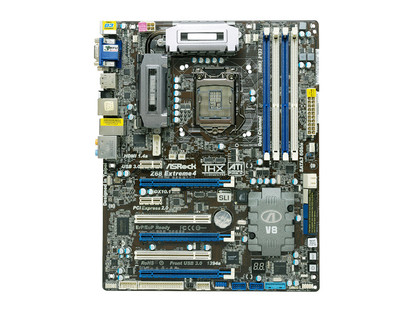
ASRock has four Z68 boards in its mobo line-up from the all-singing, all-dancing flagship Fatal1ty Z68 Professional Gen3 to the quietly confident Z68 Pro3-M.
We've got two of ASRock's new boards based on this new chipset, the Z68 Pro3 and the fuller featured and newest edition to ASRock's extensive range of boards carrying the Extreme banner, the Z68 Extreme. This sits just under the Fatal1ty Z68 board in the family line-up.
Once everybody discovered the limitations of the Sandy Bridge's launch chipsets; namely the P67's lack of support for the new processor's integrated graphics but lots of overclocking potential and the H67's graphic support but no OC-ability, keen eyes were fixed on the Z68, the next enthusiast/mainstream 6 series chipset on Intel's roadmap.
The Z68 offers the best of both worlds with integrated graphics and overclocking support.
Read the full ASRock Z68 Extreme 4 review
ASRock Z68 Pro3 - £95
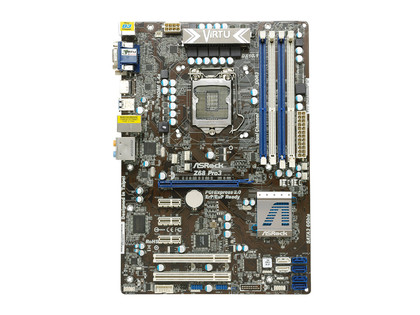
ASRock has built up a reputation for building bullet-proof mobos with very competitive price tags and the Z68 Pro 3 certainly isn't a board to let the company down on either score.
It's a bit of a surprise to see a fairly well-featured, mainstream motherboard carrying the latest Intel technology for just over a hundred quid. In our bargain-hunting terms it definitely warrants further investigation. It's so well-priced that it's worth getting if you want a no-nonsense board to try out the Z68 chipset.
It's a board that's pretty hard to look beyond too; the overclocking support of the P67 merged with the integrated graphics support of the H67, Intel's Smart Response Technology (SRT) and Lucid's Virtu software are impressive. The bundled Virtu software lets you use Intel's impressive QuickSync video encoding technology even if you have a discrete graphics card in place, and includes some healthy power-saving functions too.
One look at the board shows you where ASRock has cut the Z68 Pro 3's feature set to get it to this price and its mainstream audience: there's only a single, solitary x16 PCI-e slot. Yes, no CrossFire or SLI support.
Read the full ASRock Z68 Pro3 review
Asus RoG Maximus IV Extreme - £260
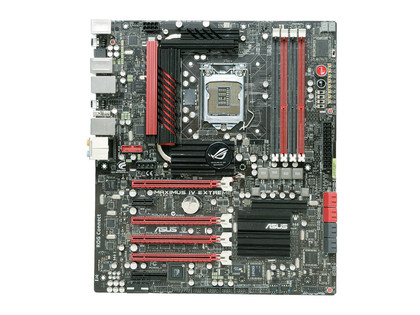
Should you see Foxconn's H61 as the Fiat 500 of this Sandy Bridge mobo group test then Asus's Maximus Extreme IV has to be the Bugatti Veyron. It's big, brash, crammed full of features and eyewateringly expensive. But then it also comes with blistering performance too.
To say the feature list of the Maximus IV Extreme is good is to do it a disservice. The list seems endless: dual channel DDR3 support up to 2,200MHz (OC), support for 3-way SLI and CrossFireX via four PCI-e slots, four SATA 6Gbps and four SATA 3Gbps and eight USB 3.0 ports on the rear panel – and that's just for starters.
You can run quad-SLI on this board if you fancy, but you'll have to pick up Asus' bizarre plug in daughter board.
Unfortunately, as the board uses the P67 chipset there's no way to access the integrated graphics of the Sandy Bridge processors but on the flip side it fully supports the overclocking capabilities of the K series Sandy Bridge CPU's. And that's what this board's all about: straight-line performance.
Read the full Asus RoG Maximus IV Extreme review
Asus P8Z68-V Pro - £147
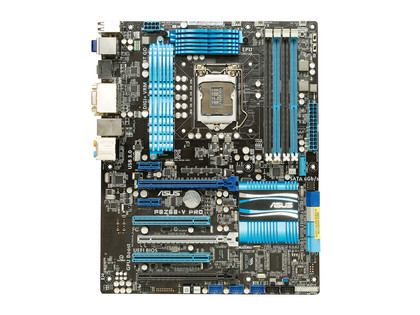
One of the first Z68 boards to break cover was the P8Z68-V Pro and it's a typical Asus board, well-built and packed to the gills with features. Intel's Z68 is the missing link between the Integrated Graphics Processor (IGP) support of the H67 and the overclocking potential of the P67 chipsets, and is a neat hybrid of the two.
You'll still need a K series processor to do the overclocking bit, but you can now overclock and use Intel's rather good Quick Sync video encoding technology with a discrete GPU plugged in too.
It, therefore, seems a bit subdued of Asus to have only five board's based around the new chipset, with two of these being in the all-singing, all-dancing Republic Of Gamers family.
If you are familiar with Asus motherboard's you might be saying to yourself: "Hang on a minute, isn't that a P8P67 Pro?" Well, yes the boards are very similar in appearance but Asus has tweaked a few things here and there, and moved components around and bringing in new ones.
Read the full Asus P8Z68-V Pro review
Foxconn H61MX - £56
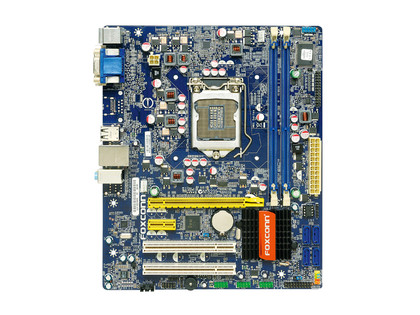
At the top end of the Intel 6 series, Sandy Bridge-supporting, chipset range there's the mighty Z68 which powers some of the most powerful and expensive motherboards around, while at the other of the scale sits the lowly, value-oriented H61.
It may be low in performance and support less built-in features compared to its flashier siblings, but in the eyes of the mobo manufacturers it is the real star of the chipset line-up as it's pitched at the end of the market where boards are made cheaply and sold by the boat load.
The H61 is a seriously pared- and cutdown version of the H67 chipset. With only the elder-statesmen of interfaces on offer: SATA 3Gbps and USB 2.0 port support, it's an ideal low-cost platform for entry level PCs.
Foxconn's H61MX doesn't add many other features over what's supplied by the chipset, and what it has added looks like it's mostly looking to the corporate market rather than the home user.
This may explain why the board has the added cost of a header for a Trusted Platform Module (TPM) and a couple of straight PCI slots which need a third party controller (the chipset doesn't natively support PCI) rather than adding a couple more video outputs other than the VGA and DVI.
Read the full Foxconn H61MX review
Gigabyte H67MA-UD2H - £95
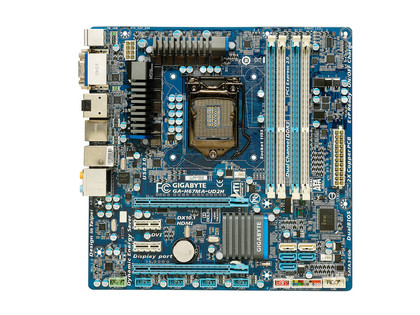
The H67 chipset may not have the overclocking capability of its performance sibling, the P67 but with its full support for the integrated graphics of Sandy Bridge processors it makes an ideal base to build a powerful home theatre PC. This hasn't gone unnoticed by mobo manufacturers as most, if not all, have H67-based microATX form factor board ranges; the format most used in HTPCs.
There once was a time when the microATX format was seen as the poor relation to full-sized ATX boards, but one one look at the feature-rich Gigabyte H67MA-UD2H tells you that those days are long gone. With its full HD and Blu-ray movie playback support, thanks to an integrated HMDI 1.4 video output, and support for Dolby Home Theater sound, the H67MA-UD2H is an ideal candidate for that powerful media PC.
On the performance side of things the H67MA-UD2H is stifled somewhat by the lack of overclocking support on the CPU side, and the chipset only supports DDR3 memory up to 1,333MHz. But then again no one would buy a H67-based board for performance; it's all about the multimedia support the boards bring thanks to the chipset.
Read the full Gigabyte H67MA-UD2H review
Gigabyte Z68XP-UD3-ISSD - £202
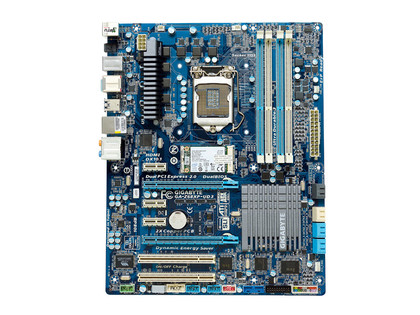
Gigabyte has wasted no time in producing boards using the new chipset, in fact you could say they have gone slightly overboard with the excitement of it all, as they have no less that 20 motherboards currently in their line-up.
That said it has almost entirely pulled out of the P67 platform, seeing the Z68 as its demise. The plan is to only produce one P67 mobo going forward.
Sitting amongst the awkwardly named Z68 line-up though are five boards (GA-Z68XP-UD3, GA-Z68XP-D3, GA-Z68AP-D3, GA-Z68P-DS3 GAZ68XP-UD3-iSSD) which all have one thing in common; they are the first desktop boards to be fitted with mSATA connections on the PCB.
This allows the mounting of a small form factor SSD to work alongside Intel's Smart Response Technology (SRT) and of the five, only the GA-Z68XP-UD3-iSSD comes with a drive already in place. The drive bundled with the board comes in the shape of one of Intel's new 20GB MLC 311 series SSDs.
Read the full Gigabyte Z68XP-UD3-ISSD review
MSI Z68A-GD65 - £150
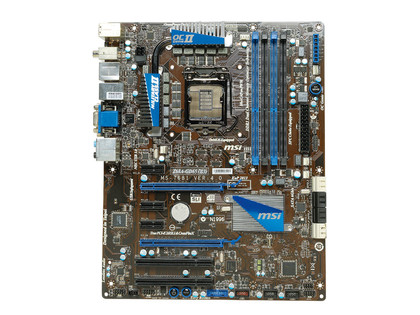
No look at any new motherboard technology would be complete without at least one example from MSI. Strangely, when you look on MSI's global website there are seven boards using Z68 but on the UK site there's just this solitary example: the Z68A-GD65 (B3). It's just as well it's a well-featured board then.
Just like the Asus P8Z68-V Pro there is more than a passing resemblance to a previous MSI P67 board; in this case the P67A-GD65. It comes with all the goodies found on MSI's better equipped boards: OC Genie II, Military Class components in the power design, APS (Active Phase Switching) Click BIOS and MSI's UEFI BIOS with its large easy to use interface.
For the time being MSI has all its UK motherboard eggs in this one basket, so how's the weave? MSI defiantly had the enthusiast in mind when it designed Z68A-GD65.
It has some features on the board that only they could appreciate; for example there is a check point block to take direct measurements of various voltages the board is using via a probe. On the bottom edge of the board there are a couple of large power and reset buttons for use with an open case or test bench.
Current page: Intel Z68 motherboard reviews
Prev Page Best Sandy Bridge motherboard Next Page TechRadar Labs becnhmarksGet daily insight, inspiration and deals in your inbox
Sign up for breaking news, reviews, opinion, top tech deals, and more.
Technology and cars. Increasingly the twain shall meet. Which is handy, because Jeremy (Twitter) is addicted to both. Long-time tech journalist, former editor of iCar magazine and incumbent car guru for T3 magazine, Jeremy reckons in-car technology is about to go thermonuclear. No, not exploding cars. That would be silly. And dangerous. But rather an explosive period of unprecedented innovation. Enjoy the ride.